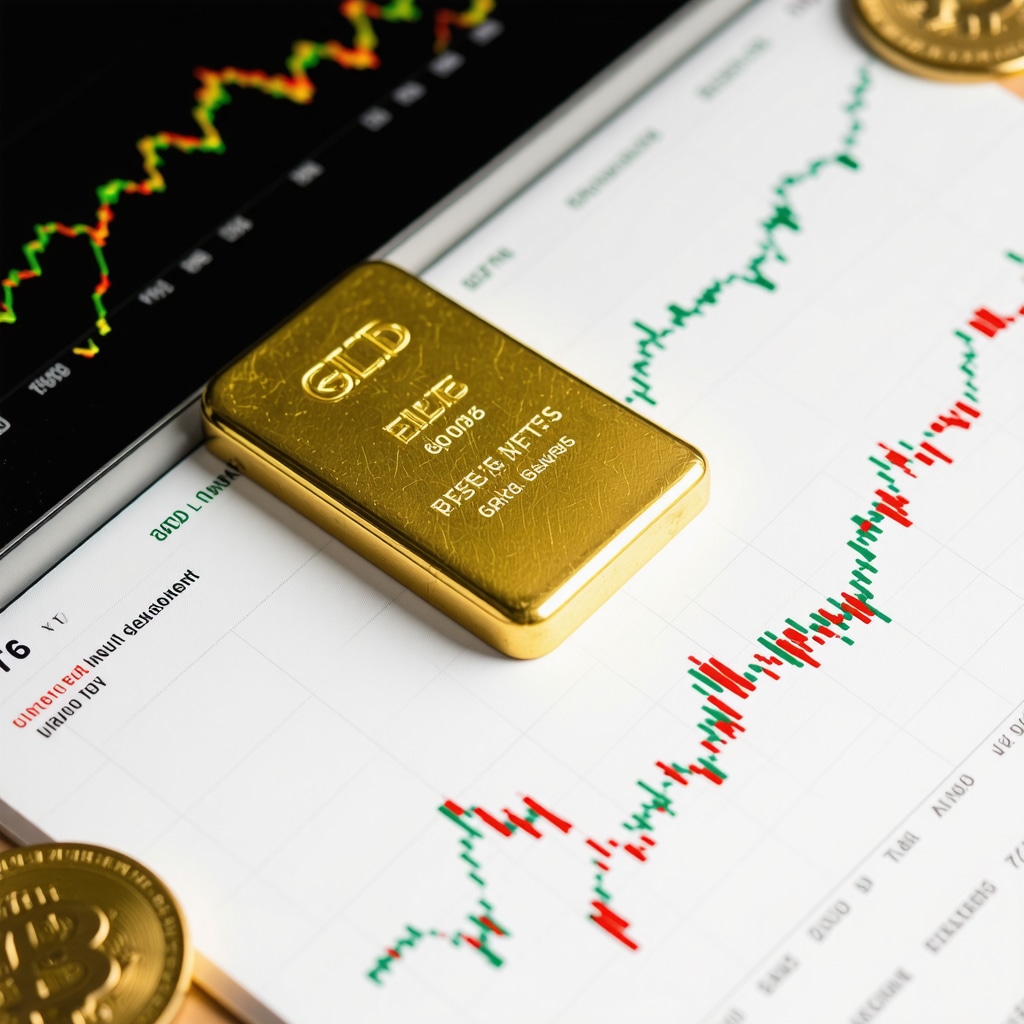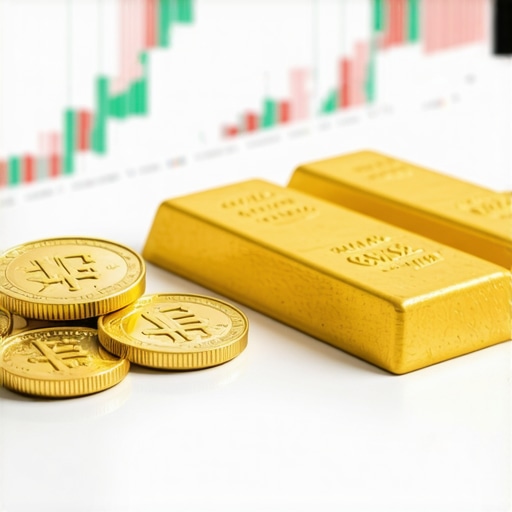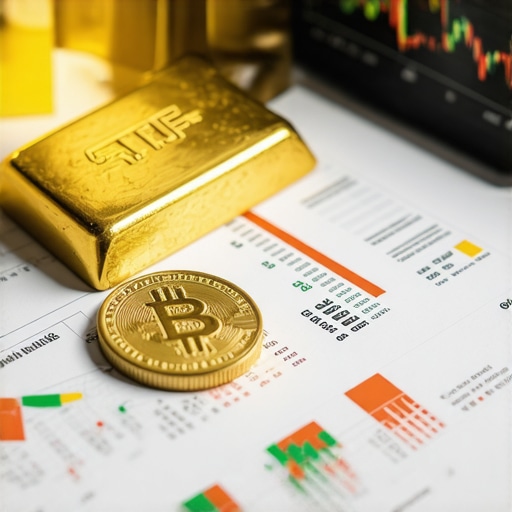How I First Faced the Choice Between Gold ETFs and Physical Gold
When I first dipped my toes into gold investing, I was overwhelmed by the choices. The decision between gold ETFs and physical gold felt like choosing between two very different paths. I remember sitting at my kitchen table, weighing the pros and cons, trying to figure out which investment matched my goals: was I after convenience, security, or long-term stability? This personal dilemma sparked my deeper dive into understanding the nuances of these options.
Why Physical Gold Felt Like Holding a Piece of Security
For me, physical gold has always had a tangible appeal. Holding a gold coin or bar in your hand provides a unique sense of security that no digital asset can replicate. I still recall the moment I bought my first gold bar from a trusted dealer, appreciating its weight and shine. Unlike ETFs, physical gold isn’t subject to counterparty risk — it’s mine, stored securely in my home safe. However, I quickly realized that storage and insurance costs, along with the risk of theft, are factors to consider seriously.
Gold ETFs: Convenience and Liquidity at My Fingertips
On the flip side, gold ETFs provided me with a hassle-free way to invest in gold without worrying about storage or authenticity verification. The ability to buy or sell shares instantly during market hours was a game changer for my portfolio flexibility. Plus, ETFs often have lower transaction costs compared to buying physical bullion. But ETFs also come with their own risks, such as reliance on the fund manager and market liquidity.
Which Investment Fits Your Goals: What Should You Ask Yourself?
When I guide others on this topic, I encourage them to reflect on key questions: Are you looking for a long-term hedge against inflation? Do you prioritize quick access to your investment? How comfortable are you with the logistics of physical gold storage? These questions helped me determine the balance between the two. For example, if you want direct ownership and a safe haven during economic uncertainty, physical gold might be your choice. If you prefer ease of trading and lower entry costs, gold ETFs could be better.
One insightful resource I found helpful was Investopedia’s guide on gold investments, which deepened my understanding of market dynamics and risks associated with each option.
Blending Both Worlds: My Strategy To Balance Convenience and Security
Eventually, I realized that a hybrid approach suits my goals best. I allocate a portion of my gold investment into physical coins and bars, secured in a private safe, while also maintaining a position in reputable gold ETFs for liquidity and growth potential. This strategy helped me diversify risk and capitalize on the unique benefits of each investment type. If you want to explore how to build a balanced gold ETF portfolio or learn about secure physical gold storage, you might find these guides useful: building a balanced gold ETF portfolio and physical gold storage best practices.
I’d love to hear about your own experiences or thoughts on gold investing. Have you leaned toward physical gold or ETFs? Feel free to share your story or questions in the comments below!
Understanding the Tax Implications: A Crucial Factor Often Overlooked
One of the more intricate aspects that caught my attention as I delved deeper into gold investing was the tax treatment differences between physical gold and gold ETFs. Physical gold, when sold, is often taxed as a collectible asset in many jurisdictions, which can mean higher capital gains rates compared to stocks or ETFs. This subtle but impactful difference can significantly affect your net returns, especially if you plan to hold gold for the long term. On the other hand, gold ETFs are usually taxed like stocks, offering potentially more favorable tax treatment depending on your country’s regulations.
For investors keen on maximizing post-tax profits, understanding these nuances is essential. I recommend consulting a tax professional or financial advisor familiar with precious metals investments to tailor strategies that align with your tax situation. This attention to detail is part of what distinguishes seasoned investors from beginners.
Evaluating Counterparty and Authenticity Risks in Gold ETFs and Physical Gold
Another dimension I considered seriously was the risk of counterparty default or authenticity issues. While physical gold eliminates counterparty risk by virtue of direct ownership, it introduces concerns around verifying authenticity and secure storage. I recall the importance of purchasing from trusted dealers and even getting certificates of authenticity to mitigate fraud risks.
Conversely, gold ETFs depend on the fund managers and custodians to hold the physical gold securely. Although reputable ETFs undergo regular audits, the risk, however minimal, of mismanagement or fraud is not zero. This complexity requires investors to perform due diligence on ETF providers, their holdings transparency, and regulatory compliance.
How Can You Balance Liquidity Needs with Security Concerns in Gold Investments?
This question often arises among investors navigating gold options. Personally, I found that defining my liquidity requirements upfront helped streamline my asset allocation decisions. For instance, if you anticipate needing quick access to funds, a larger ETF allocation provides market liquidity with minimal hassle. However, if your priority is a secure store of value insulated from market and systemic risks, holding physical gold is prudent.
Balancing these priorities might involve a dynamic approach, adjusting ETF and physical gold proportions according to evolving economic conditions and personal financial goals. This approach aligns with insights shared by financial experts like those at Morningstar, who emphasize portfolio diversification and risk management when incorporating gold investments (Morningstar on gold investment strategies).
Leveraging Technology to Enhance Gold Investment Management
In recent years, technology has transformed how I manage gold investments. Mobile apps and online platforms enable real-time tracking of gold prices and ETF performances, allowing me to make informed decisions swiftly. Some services even offer secure digital vaults for physical gold storage, combining the tangible security of bullion with modern conveniences.
Furthermore, blockchain technology is beginning to influence the gold market by providing transparent provenance tracking and facilitating tokenized gold assets. This innovation has the potential to reduce counterparty risks and improve liquidity, making gold investments accessible to a broader audience with enhanced security.
If you are curious about how to integrate these technological advances into your portfolio, resources like the mastering gold trading techniques guide offer practical insights.
Have you experimented with technology to optimize your gold investments? What tools or platforms have you found indispensable? Share your experiences or questions in the comments — your insights could help fellow investors navigate this complex market!
When Market Volatility Tests Your Gold Investment Choices
One of the most profound lessons I’ve learned is how gold behaves under pressure—especially during heightened market volatility. Early in my investment journey, I noticed that physical gold often felt like an unshakable refuge during financial storms, yet gold ETFs offered the agility to respond quickly to fluctuating market conditions. This dichotomy made me realize that understanding the economic context is paramount before deciding how much of each to hold.
For example, in times of geopolitical tension or currency weakness, physical gold’s intrinsic value shines as a tangible asset insulated from digital market disruptions. However, during periods of rapid market swings, ETFs allow me to rebalance or liquidate positions instantly, seizing opportunities or cutting losses without the delays physical gold might impose.
Delving Deeper: How Do You Measure True Cost of Ownership Between Gold ETFs and Physical Gold?
Have you accounted for the hidden expenses that subtly erode your gold investment returns?
This question became a turning point in my approach. Beyond the obvious purchase price, owning physical gold involves storage fees, insurance, and sometimes even transportation costs if you decide to move your bullion. These expenses can quietly chip away at your returns over time.
Conversely, gold ETFs come with management fees and bid-ask spreads that might seem negligible but accumulate with frequent trading. The ongoing expense ratio of an ETF is a subtle drain on your investment growth, often overlooked by beginners.
My strategy evolved to include a detailed comparison of these costs over a multi-year horizon. Resources like smart gold investment strategies to protect wealth helped me quantify these factors and plan accordingly.
The Psychological Comfort: Why Emotional Factors Matter in Choosing Gold Investments
Beyond calculations and logistics, I discovered that emotional comfort plays a surprisingly large role in my investment satisfaction. Holding physical gold provides a palpable sense of security—something I can see and touch. It’s almost primal, harkening back to millennia where gold was a universal store of value.
On the other hand, ETFs, while efficient, feel more abstract—numbers on a screen that depend on market intermediaries. For some investors, this can induce anxiety, especially in turbulent times. Recognizing this, I’ve learned to respect the emotional dimension of investing, balancing it with cold, hard facts.
Does Blending Gold Investments Require Constant Reassessment?
How often should you recalibrate your mix of physical gold and ETFs to align with evolving market and personal conditions?
From personal experience, I realized that a “set it and forget it” approach doesn’t work well with gold investments. Economic trends, inflation expectations, and even personal financial needs shift over time, necessitating periodic review of my gold portfolio.
For instance, during periods when inflation fears rise, increasing physical gold holdings felt prudent as a direct hedge. Conversely, when liquidity and market access became priorities, I leaned more heavily into ETFs. This dynamic balancing act requires vigilance and flexibility.
Financial thought leaders at Morningstar also emphasize this adaptable mindset in their guide on gold investment strategies, which has been instrumental in shaping my approach.
I’d be really interested to hear how you manage this balance in your portfolio. Do you have a routine for portfolio reassessment? What triggers your decision to adjust gold allocations? Sharing your approach could provide valuable perspectives for all of us navigating these decisions.
Refining My Approach: Integrating Market Sentiment and Macroeconomic Indicators in Gold Allocation
Over time, I realized that gold investing transcends mere asset selection; it demands a nuanced understanding of macroeconomic cues and market psychology. I began incorporating leading indicators like inflation expectations, real interest rates, and geopolitical developments into my decision matrix. For example, when real yields turn deeply negative, physical gold’s allure intensifies as an inflation hedge and store of intrinsic value. Conversely, during periods of stable economic growth and rising real rates, ETFs provide nimble exposure to capitalize on market momentum.
This dynamic framework helped me avoid static allocations and embrace a more responsive, data-driven strategy. It aligns well with insights from CFA Institute’s research on the investment implications of gold, which underscores gold’s multifaceted role depending on economic regimes.
Exploring Tax-Efficient Structures: How I Navigate Jurisdictional Complexities
Delving deeper into tax strategies revealed the importance of tailoring gold investments to jurisdictional nuances. For instance, in certain countries, physical gold holdings incur collectible capital gains tax rates, while specific gold ETFs are structured to qualify for equity-like tax treatment. This dichotomy compelled me to engage with tax advisors who specialize in precious metals, enabling me to optimize after-tax returns.
Moreover, I explored gold-focused mutual funds and trusts that offer alternative tax advantages and diversification benefits. These vehicles can sometimes circumvent the higher tax burden associated with direct bullion ownership, as detailed in guides like the ultimate guide to gold mutual funds for long-term investors. This layer of sophistication is essential for high-net-worth investors and those seeking to preserve wealth across generations.
How Do Advanced Investors Leverage Derivatives and Structured Products to Enhance Gold Exposure?
For those comfortable with complexity, derivatives such as gold futures, options, and structured products open avenues for tactical positioning and hedging. Personally, I dabbled cautiously in gold options to hedge downside risk while maintaining upside potential, appreciating how this can complement physical and ETF holdings.
Structured products linked to gold enable tailored risk-return profiles, often combining gold exposure with yield enhancement or capital protection features. However, these instruments demand rigorous due diligence and understanding of counterparty credit risk.
For investors eager to explore these advanced tools, resources like mastering gold trading techniques provide invaluable practical insights.
Inviting You to Share Your Journey: Let’s Push the Boundaries of Gold Investing Together
Gold investing is a deeply personal and evolving journey. I encourage you to share your sophisticated strategies or challenges you’ve encountered when balancing physical gold and ETFs. How do you integrate tax considerations, market signals, or advanced instruments into your portfolio? Your stories and questions enrich this collective exploration and help us all navigate the multifaceted gold market with greater confidence.
Things I Wish I Knew Earlier (or You Might Find Surprising)
The Emotional Pull of Physical Gold Can Be Stronger Than You Expect
When I first started investing, I underestimated how much owning physical gold would affect my peace of mind. It’s not just an asset; it’s a tangible reassurance, especially during uncertain times. That feeling of holding something real, something centuries-old as a store of value, is surprisingly powerful and can influence your investment decisions more than you realize.
Liquidity Isn’t Always as Simple as It Seems
Gold ETFs promise quick trading, but I learned that in times of extreme market stress, liquidity can tighten unexpectedly. Conversely, selling physical gold isn’t instant but having direct ownership means fewer surprises about what you actually own. Balancing these realities early on helps avoid frustration later.
Tax Implications Can Steal More Than You Think
At the start, I overlooked how tax treatment varies widely between physical gold and ETFs. Knowing that collectible taxes might apply to bullion sales while ETFs often get stock-like tax treatment has saved me from costly mistakes. It’s worth consulting a tax expert early—trust me, it pays off.
Storage Costs Are a Silent Drag on Returns
Physical gold’s safety comes at a cost. Insurance, secure storage, and even transportation add up over time. Initially, I didn’t factor these in enough, which shifted my net investment returns. Recognizing these hidden expenses helped me balance my portfolio more realistically.
Technology Is Changing the Game
I was surprised at how digital tools and even blockchain-based gold tokens started to reshape traditional gold investing. These innovations offer new ways to verify authenticity, track provenance, and improve liquidity. Staying informed about these trends has become part of my ongoing strategy.
Reassessment Is Key—Gold Investing Isn’t Set and Forget
Gold markets and personal circumstances evolve. I learned that regularly revisiting my gold allocations, in light of economic indicators and personal goals, keeps my portfolio aligned and responsive. This ongoing attention makes all the difference.
Resources I’ve Come to Trust Over Time
Investopedia’s Guide on Gold Investments: A fantastic starting point that helped me understand the basics and risks associated with both physical gold and ETFs. It’s clear, well-researched, and accessible for all levels.
Morningstar’s Gold Investment Strategies: Their deep dives into portfolio diversification and risk management have shaped how I balance gold in my overall investment mix. I often revisit their insights when market conditions shift.
CFA Institute’s Research on Gold: For those wanting a more academic perspective, their analysis on gold’s role across economic regimes added much-needed depth to my strategy, especially around macroeconomic indicators.
Buying Gold Now’s Guides: This website has been a treasure trove—from building a balanced gold ETF portfolio to best practices for storing physical gold, their practical advice helped me take actionable steps with confidence.
Mastering Gold Trading Techniques: For anyone looking to sharpen their tactical approach, this guide (mastering gold trading techniques) offers real-world strategies that go beyond the basics.
Parting Thoughts from My Perspective
Choosing between physical gold and gold ETFs isn’t about picking a winner; it’s about understanding what each brings to your portfolio and aligning that with your personal goals and comfort level. My journey showed me that blending these options creates a dynamic, resilient approach—combining the tangible security of bullion with the liquidity and convenience of ETFs.
Remember, gold investing goes beyond numbers and charts; it intertwines with emotional factors, tax considerations, and evolving market environments. Keep learning, stay flexible, and don’t hesitate to seek trusted advice. If this resonated with you, I’d love to hear your thoughts or experiences in the comments. Sharing our journeys enriches us all.











I really appreciate this comprehensive overview of the pros and cons of physical gold versus ETFs. Like many new investors, I initially struggled with the balance between tangible security and liquidity. Your point about the emotional comfort of holding physical gold resonated with me; there’s an unmistakable sense of trust when you can see and touch your assets. At the same time, the flexibility of ETFs during volatile markets is hard to ignore. In my experience, combining both strategies has helped diversify risk while providing peace of mind. One challenge I’ve faced is navigating the tax implications, especially in different jurisdictions—it’s something I definitely plan to consult professionals on before making major moves. Curious—how do others manage the emotional aspect of owning physical gold, especially during downturns? Do you find that the comfort of tangible assets still outweighs the convenience of ETFs in turbulent times?